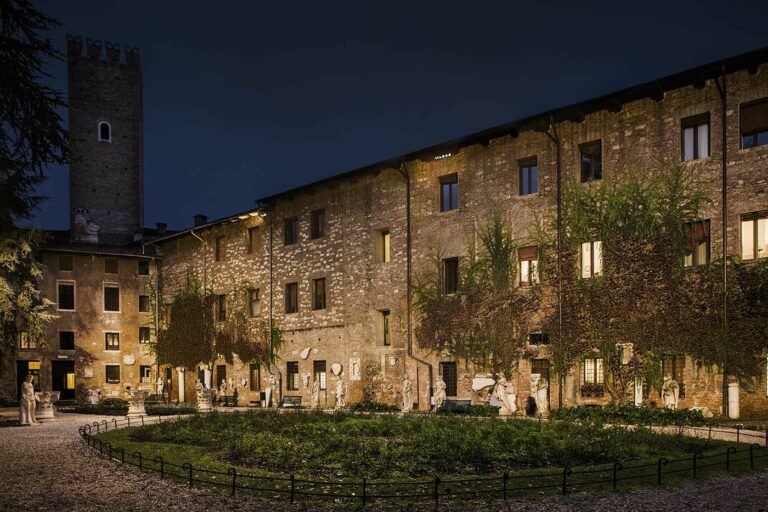
The Teatro Olimpico (Olympic Theatre) in Vicenza, Italy, is widely regarded as the oldest theatre in the world. Its first performance took place roughly 550 years ago, in 1585. Other than its respectable age, the Teatro Olimpico is also one of the most beautiful theatres in Europe and perhaps the world. It was designed by Andrea Palladio, an Italian architect, and a master of Renaissance architecture. Nowadays, the building is a UNESCO World Heritage Site.
The ancient theatre was commissioned towards the end of the 1570s by the Vicenza Olympic Academy. Andrea Palladio was a renowned local architect and one of the academy’s founders. So, naturally, the contract went to him.

But unfortunately, Palladio died only six months after the construction work commenced, in August of 1580. With all of Palladio’s original plans in hand, another prominent Vicentine architect, Vincenzo Scamozzi, took over.
All the interior designs of the building structure had already been finished by Palladio at the time of his death. So, Scamozzi only needed to provide additional designs for the auditorium and the stage.
Even though Scamozzi finished the design for Teatro Olimpico, the theater remains a towering example of Palladio’s architectural genius.
Considering the historical time in which the Teatro Olimpico was constructed, the venue with all its delicate detail and grandeur didn’t take a long time to build at all. After about five years of massive construction work, the theatre opened to the public on March 5th, 1585.
However, even though the theatre was majestic, and the performances were allegedly brilliant as well, featuring only the best ensembles, the Teatro Olimpico was abandoned after only about a dozen productions.
The scenery consisted of seven hallways decorated to create the illusion of looking down the streets of a city from classical antiquity. Ancient Thebes was to be the setting for the first play staged in the theatre.
A set of seven extraordinarily realistic trompe-l’œil false perspectives provide the illusion of long street views. While, in reality, the sets recede only a few meters.
Scamozzi’s original lighting system of glass oil lamps increased the risk of fire and was also rather costly. Thus, it was never used much.
Surprisingly, the antiquated lighting system was revived in modern times. This happened in 1997, when the Teatro Olimpico presented yet another production of Oedipus the King.
In 1994, the Teatro Olimpico was named a UNESCO World Heritage Site. In view of its incredibly well-preserved state, as well as its significance to the history of Renaissance architecture.
It is still used for musical performances and plays. But access to the theater is limited due to this ancient building’s fragile state. To keep the stress to the building to a minimum, the size of the audience in the theater is kept rather small with the auditorium only accommodating an exclusive four-hundred seats.
In the Teatro Olimpico, performances take place during two theater seasons.
The Il Suono dell’Olimpico festival takes place during spring season while performances with classical plays are held during the autumn season.
Just as the number of spectators, the theater’s infrastructure is also strictly monitored and limited to protect the building as best as possible.
Thus, no air conditioning or heating system has been installed. The concern there is mostly that unnatural, sudden temperature shifts might destroy the delicate wooden structures.
Apart from theatrical performances, the Teatro Olimpico is also used by the American Department of Defense high school located in Vicenza for their annual graduation ceremony, each June.
In 1979, Don Giovani was filmed in and around the theatre. In 2005, the venue was used as a filming location for the movie Casanova.
Over the centuries, the Teatro Olimpico has had many admirers, but relatively few imitators.
One critic observed: “In the history of theatre design, the Teatro Olimpico was a temporary hiatus, for succeeding generations adopted the proscenium arch and painterly stage sets. Palladio’s ideas were closer to the spirit of the modern theatre, which favors the relationship of audience to action.”
The Teatro Olimpico on Wikipedia
Teatro Olimpico Official Website
When Sailors Were Stagehands – Debunking a Bit of Rigging History
10 Strange Theatre Terms and Their Meanings


Liam Klenk was born in Central Europe and has since lived on four continents. Liam has always been engaged in creative pursuits, ranging from photography and graphic design, to writing short stories and poetry, to working in theatre and shows. In 2016, Liam published his first book and memoir, 'Paralian'.
Read Full Profile© 2021 TheatreArtLife. All rights reserved.

Thank you so much for reading, but you have now reached your free article limit for this month.
Our contributors are currently writing more articles for you to enjoy.
To keep reading, all you have to do is become a subscriber and then you can read unlimited articles anytime.
Your investment will help us continue to ignite connections across the globe in live entertainment and build this community for industry professionals.